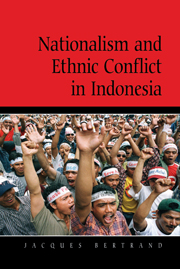Book contents
- Frontmatter
- Contents
- List of figures and tables
- Preface
- Maps
- 1 Introduction
- 2 Critical junctures, nationalism, and ethnic violence
- 3 The national model and its institutional history
- 4 Exclusion, marginality, and the nation
- 5 Islam and nation: The Muslim–Christian dimension
- 6 The escalation of religious conflict
- 7 Conflict in Maluku
- 8 Late integration into the nation: East Timor and Irian Jaya (Papua)
- 9 Aceh's ethnonationalist conflict
- 10 Autonomy as a solution to ethnic conflict
- 11 Unity in diversity
- Notes
- Glossary
- Bibliography
- Index
- CAMBRIDGE ASIA–PACIFIC STUDIES
3 - The national model and its institutional history
Published online by Cambridge University Press: 10 December 2009
- Frontmatter
- Contents
- List of figures and tables
- Preface
- Maps
- 1 Introduction
- 2 Critical junctures, nationalism, and ethnic violence
- 3 The national model and its institutional history
- 4 Exclusion, marginality, and the nation
- 5 Islam and nation: The Muslim–Christian dimension
- 6 The escalation of religious conflict
- 7 Conflict in Maluku
- 8 Late integration into the nation: East Timor and Irian Jaya (Papua)
- 9 Aceh's ethnonationalist conflict
- 10 Autonomy as a solution to ethnic conflict
- 11 Unity in diversity
- Notes
- Glossary
- Bibliography
- Index
- CAMBRIDGE ASIA–PACIFIC STUDIES
Summary
Indonesia's national model has been based on the concept of a single, Indonesian nation. Constructed out of diverse peoples spread across a vast archipelago, at its origins it was only a vision for establishing a new polity that would unify groups of different ethnicity, size, contact with the modern world, and experience with colonial rule. After independence, struggles within the political elite showed profound disagreements over its character and the best way to ensure its unity. They included issues such as the nation's secular or religious basis, and the degree of ethnic representation. Once a compromise was reached, subsequent institutional changes were highly constrained by the original concept.
Three critical junctures were particularly salient. The first corresponded to the decades during which the Indonesian nation was constructed. The rise of Indonesian nationalism competed with different political alternatives during decades of colonial decline, revolution, and war. At the end of the juncture in 1950, political leaders reached a compromise to institutionalize the Indonesian nation in the form of a unitary state and modern, liberal democratic political institutions. The second juncture began during the mid-1950s and ended only with the establishment of a military-dominated authoritarian regime, the New Order, which was consolidated around 1968. New political institutions were created to firmly entrench a vision of the Indonesian nation that focused on unity through the formation of homogenous political, social, developmental, and even some cultural characteristics for all of Indonesia's diverse ethnic groups.
- Type
- Chapter
- Information
- Nationalism and Ethnic Conflict in Indonesia , pp. 28 - 44Publisher: Cambridge University PressPrint publication year: 2003



